
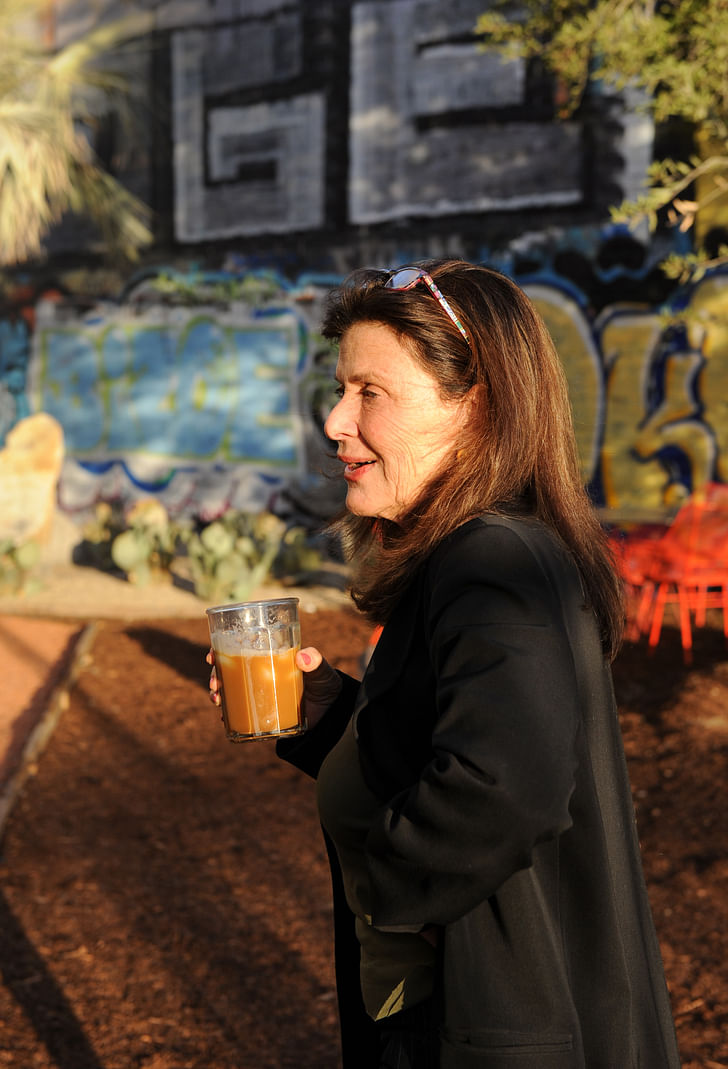
The city within a city is a common architectural idea, but few times does one have an opportunity to experience this loose concept as a physical reality. Studio-MLA captures the essence of this dynamic interior urbanism, as it situates itself as a kind of indoor campus greenhouse. But, instead of districts and cities, there are conference rooms, workstations, plazas, and outdoor environments designed to enrich and enlighten the experience of its users. Color, light, and space delineate the the unique character of Studio-MLA, a character that radiates from the studio's eclectic leader and founder, Mia Lehrer.
For our latest Studio Visit, Archinect’s Paul Petrunia sat down with Mia Lehrer to talk about the city within a city that is Studio-MLA, its many uses, the workplace culture, and its special place as a community hotspot.
How do you define this part of L.A. where your office is?
Well, I like to call it the Mission District on the East Bank.
Is that your own name for it?
No, we've talked with a few people who have spaces here, it's the Maker's District or the Mission District
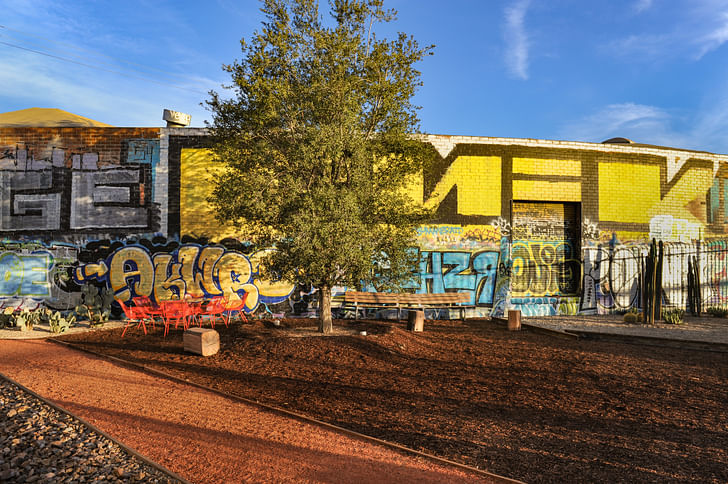
How long have you been here?
I've been here for a year and I was in a space not far from here a year before that and before that, I was at the Wiltern. I needed more space. And I was looking to have a space that allowed for a lot of exploration and model making and just a creative place to be to allow for creative expression.
And how would you define this part of the city within the context of the city?
This is an industrial area that was waning. This particular building was a steel rolling factory and there hadn't been employees here for like seven years. And I found this place through a woman who actually had her office here for 30 years. I met her through friends and she told me that this building was here.
Did you buy the building?
I co-own this building.
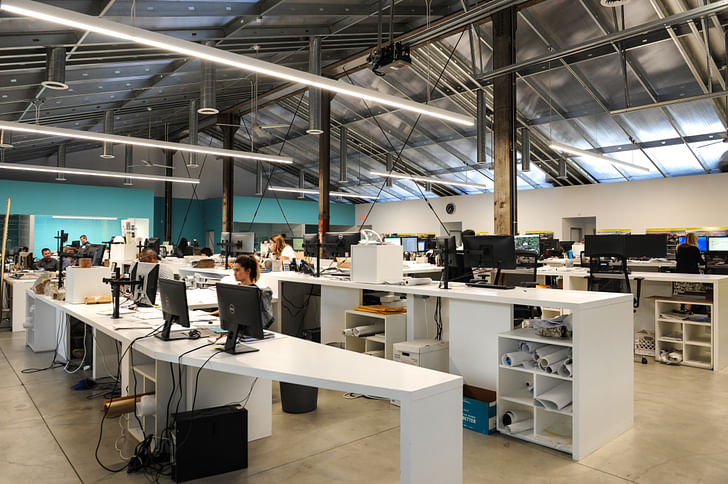
How do the people that work here get here?
A lot of them do come on the gold line or bike or scooter. I would say half of them come by car.
This is such an eclectic mix of spaces here. How would you define the work environment in terms of spatial character?
Basically, the studio, which you haven't walked into, the glass, the shed, is a big open studio with a couple of smaller meeting rooms. But it's a big open studio. This is called the Plaza.
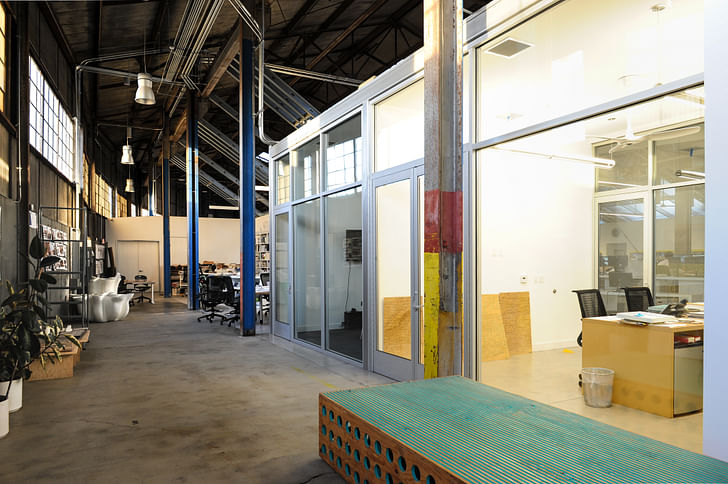
The room we're in right now?
No, this is a conference room and that's the plaza with the kitchen. And it's just a convening space. This is where lunch happens. This is where we have conversations and events. People are basically sitting on the steps, looking at the presentation, and then there are breakout rooms or there's drinking. The Sierra Club came here to have their award ceremony. Genesis L.A. had their 20th anniversary here. We've had a series of events. And that's how we conceptualize this space. That's a convening space for the community. And the garden too.

Do you often invite people from outside the office to the space. And if so, how often?
Well, there will be people who want to come here. For instance, a community group from the Arts District wanted to use the space for a design review for a project. And so I said, sure, nobody's going to be in the conference room, you can just have it. So, it becomes that kind of situation. We really like having people. Like I told you, the county sustainability plan, a full day here with some really interesting conversations about the future of the city and environmental equity and social equity and inclusion.

How do they use the space? Are they usually just limited to the plaza area?
No. So in the case of that, the presentation was there and it fits a hundred and fifty people.

On that large screen?
Yes. But the steps too. And then we put these yellow benches facing in. And then you had one group here. You had another group in our library that you didn't see. And then you had another group in the smaller space over there where the table is. And people were having these workshops. So it's just flexible.
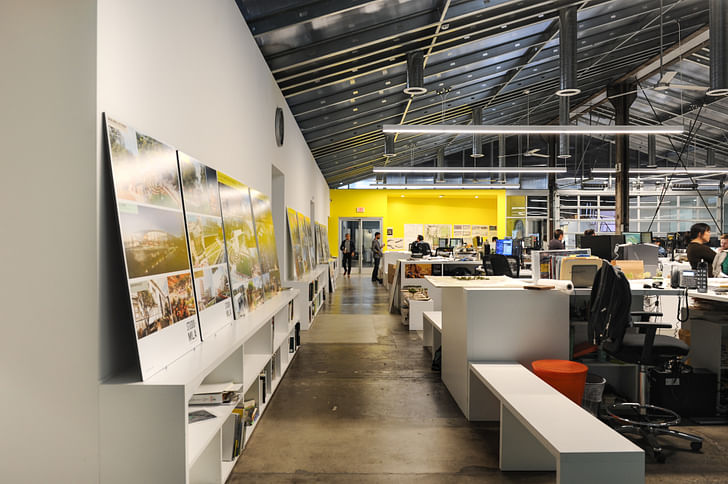
Where are your favorite spaces to be in this new work environment?
Oh, that's a really good question. I like the top of the deck here. Yeah. I like being up there. I hide up there sometimes.
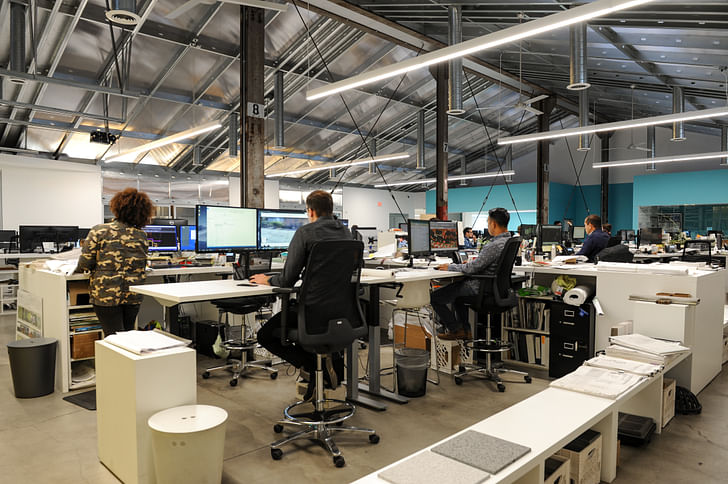
Where do the architects and designers, landscape architects in your office come together to collaborate and socialize?
Well, in this plaza and outside in the garden. And we worked together with about four of the designers on the layout of the space and it's very generous. So there are pods of about six people and there's about 10 of those. And people spontaneously meet or if there is a special meeting, we have the small conference rooms where they can go. But you will sometimes find people talking about a design over here on the picnic tables because they just want to get away from the space.

Where do people eat lunch? Do they bring lunch? Do they eat out?
It's half and half. They'll go out to get lunch and come back. They'll go to the Arts District or Boyle Heights and get lunch and come back. Some people bring lunch. At least once a week we provide lunch for a lunch and learn or a birthday lunch. We have a lot of companies who want to come here and talk about their products.
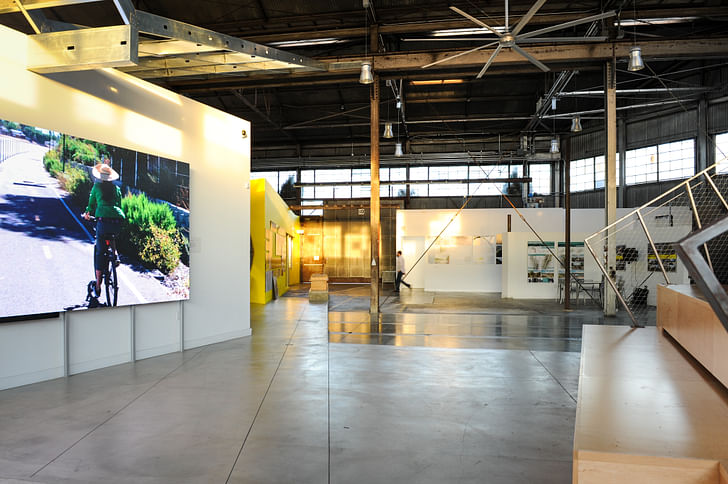
Yes. And there is one that is really funny. It's actually a food truck, but it only goes to this one spot for about three hours at lunch and then it leaves. It's not like it would come here. They go where they go. And people walk to the Arts District because you can just walk across the river. If you want to go on a walk, a 15, 20-minute walk, it works out.
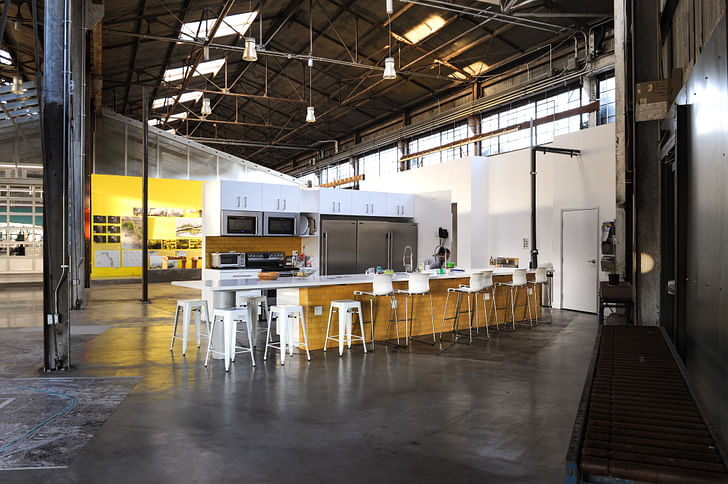
Are there office pets?
Office pets? No. Well, there are birds that live in the building, birdies. We encourage them and leave them food.
They’re wild?
They're a little wild. But they're well behaved. When they're nesting, they stay inside and otherwise they get out because we have these huge garage doors and they come in through the top of the garage door. But the truth is that there are a couple of people that are scared of pets. Otherwise, dogs would be the next step.

And what about music? Do you ever play music out loud or do people listen to music privately?
They listen to their own music. The echo in the building is sometimes a little intense. But, when there are events, there's music. We're not against music.
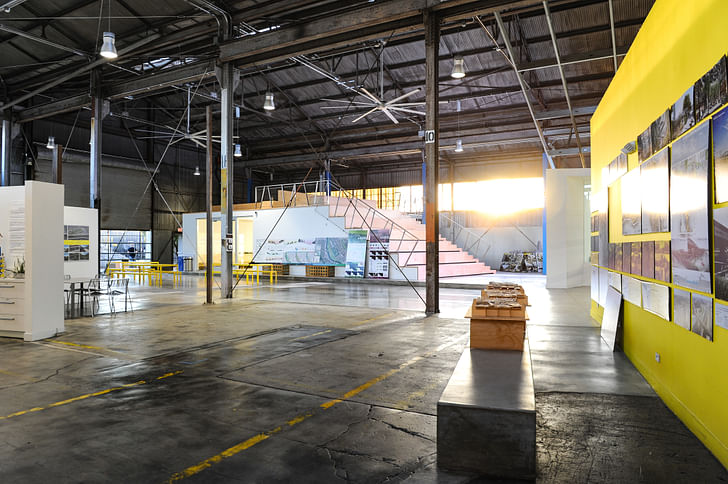
This is a very unique type of workspace. It kind of feels like a campus in a way. It's almost like a small urban planning project. And as I was mentioning before, I love the kind of building within a building feel where you don't know if you're outside or inside. What was the concept? Was it an empty building when you took it over?
Yeah, it was a huge, dirty, crazy, empty building with a lot of broken windows. It became clear that it was awesome when you entered because the scale was really large: wide, high, long. It felt like you had to tame it, if nothing else, for practical reasons, to create the practical space providing the utilities and heating and air conditioning and computers and everything.
And so, the greenhouse concept became something that we thought was a nice analogy to what we do. It's a building within a building. And it's a greenhouse. We concluded that we also wanted this coworking space, which is what the plaza really is. But also convening space. So it's evolving because we didn't design everything to a T. We were seeing how it worked, and it's worked really well. I love our picnic tables; they get moved around, people do things with them. People go on to the stepped area and just get away and think or read or do computer work. It's evolving.
So you think it may still transform over time?
Yes. You know, occasionally, I think, wouldn't it be nice to have some more enclosed spaces? Maybe hire an artist or maybe work ourselves. Maybe some, you know, 20 by 20 little cubicle spaces that people can go and hide in when they're really wanting to focus.

Was this anything like any of your previous studio spaces?
Well, in the main studio are white desks that are organized in rows. But, otherwise, no. I mean, the scale is...it's the wow scale, right? I was lucky too and I was also willing to come to the edges of the city and the edge of the river and along the rail. It's probably pretty scary to some people. It goes with the package. "Just do it," right? Some of my peers were here for a conference and we held one of the meetings here. They all have tight offices in big cities like New York. They were all really excited and jealous. I wonder how it will impact the kind of work that we do. Just the sense of openness. It's interesting to me, on the woman side of things.
I was sitting next to somebody the other day. It was a guy from Rem Koolhaas' office. A Latino. He's from Boyle Heights, works in the New York office. We've been working together on a couple of projects for six to seven years. They were here because we just opened the Wilshire Temple and breaking ground on the Wilshire Temple building additions. We're working on FAB-Park together, and he said, "so you have about five or six people, right?" And then it's like, "and you only work in Los Angeles, right?" What do you do with that?
So, for one, do we do enough to let people know who we are and what we do? I mean, definitely the OMA crew needs a little presentation, but that's just the assumption.

Well, I mean, you guys do big projects. I would assume...
But, I mean, his initial assumption is we're doing these two projects, he never looked us up, I guess...
I see. He wasn't familiar with the body of work.
That's right, the body of work. And then it's just the assumption. It's a lady and that's what it must be.
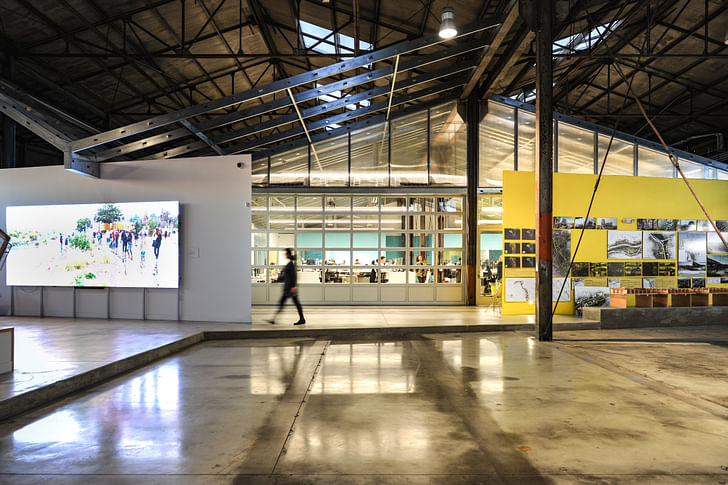
Interesting. Interesting, but unfortunate.
Yes. Do you have a daughter?
I do. And she is a born feminist. She came out of my wife as a feminist. And she's a great feminist. She's the only girl on her 22 member tennis team. And she's the best player on the team.
That’s great.
And she loves every minute of that. She loves beating all the boys.
That’s great.
Paul Petrunia is the founder and director of Archinect, a (mostly) online publication/resource founded in 1997 to establish a more connected community of architects, students, designers and fans of the designed environment. Outside of managing his growing team of writers, editors, designers and ...
Sean Joyner is a writer and essayist based in Los Angeles. His work explores themes spanning architecture, culture, and everyday life. Sean's essays and articles have been featured in The Architect's Newspaper, ARCHITECT Magazine, Dwell Magazine, and Archinect. He also works as an ...
9 Comments
Great to see MLA featured.
“It's a lady and that's what it must be.“ Oof...
And I mean, she/they are certainly not a new name...though perhaps a bit "regional"?
I think it with the east coast/male myopia..
keep in mind that was Mia's perception of what the male man was saying. She even says it was his 'assumption'. But male or female, I don't know what other projects my consultants are working on unless they tell me. You kind of do feel like the consultant is only working on your project, and that has nothing to do with her being a her.
It was Mia's assumption that that was his assumption, or so I assume.
THE ASS HAS GONE FROM U TO ME
A lot of talented younger generation architects and landscape architects have been through her office. No wonder it looks like a school many new graduates would like to go. School of Mia. Thumbs-up.
I'd love to eat my daily lunch there!
meet me under the bigass fan!
Block this user
Are you sure you want to block this user and hide all related comments throughout the site?
Archinect
This is your first comment on Archinect. Your comment will be visible once approved.